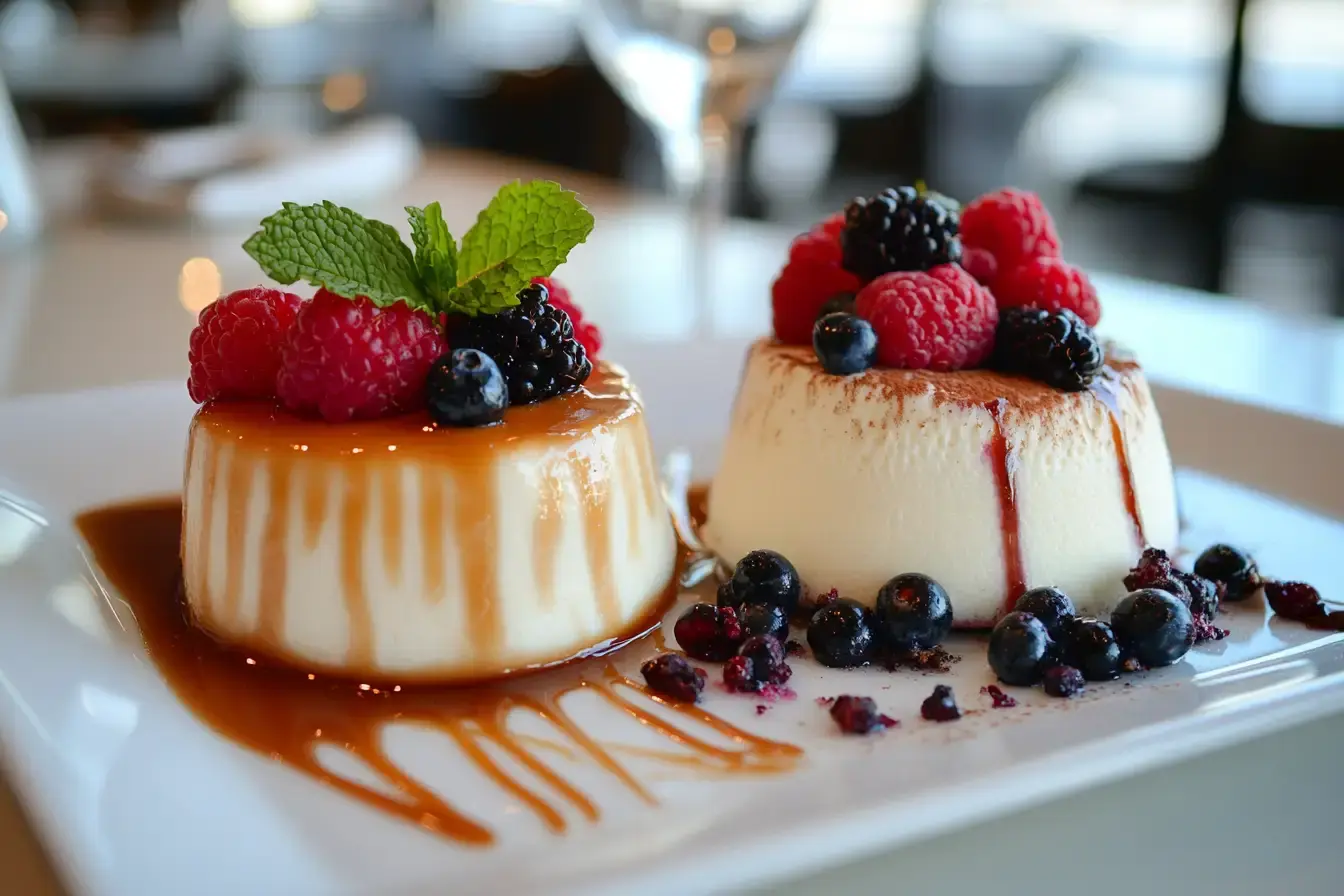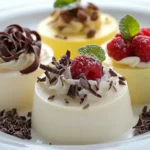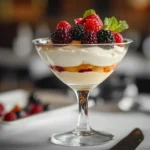I’ve always had a soft spot for creamy, indulgent desserts. Whether it’s a silky pudding or a delicate mousse, I can’t resist a spoonful of something smooth and luscious. That’s why Bavarois and panna cotta have become two of my absolute favorites. Both are elegant, simple to make, and taste like pure decadence. But here’s the thing—while they might seem similar at first glance, they each have their unique charm. If you’ve ever wondered what sets them apart or how to make them just right, you’re in for a treat!
“Is Bavarois the same as Panna Cotta?
No, Bavarois is a richer custard, while Panna Cotta is a simpler, cream-based dessert.”
Why I Love Bavarois and Panna Cotta
Panna cotta is like the classic, no-fuss Italian dessert that’s all about simplicity. It’s rich yet light, firm yet creamy, and barely takes any effort to whip up. On the other hand, bavarois feels a little fancier—it’s like a mousse and a custard had a love child. The difference? Bavarois gets its airy texture from whipped cream, while panna cotta relies on pure creaminess. Both are so good and honestly, I can never pick just one.
The best part? They’re incredibly versatile. You can infuse them with vanilla, chocolate, coffee, or even fruity flavors like mango or raspberry. They’re the perfect canvas for creativity, and I think you’re going to enjoy making them at home!

Key Ingredients for the Best Bavarois and Panna Cotta
To make these desserts just right, you need a few key ingredients. The good news? You probably have most of them in your kitchen already.
- Heavy Cream: The heart of both desserts. I like to use full-fat cream for the richest flavor and smoothest texture.
- Milk: Lightens up the creaminess slightly, balancing the richness. You can use whole milk or even a dairy-free alternative like almond milk.
- Gelatin: The magic ingredient that gives both desserts their signature wobble. I go for unflavored gelatin, but you can also use agar-agar if you prefer a vegetarian option.
- Sugar: Just enough to sweeten things up. You can use white sugar, honey, or even maple syrup for a different depth of flavor.
- Egg Yolks (for Bavarois): This is where Bavarois gets its custard-like feel. They add richness and make the texture silky smooth.
- Vanilla Extract: A simple but essential ingredient for adding that warm, sweet aroma. You can swap it out for citrus zest, coffee, or even a splash of liqueur.
- Fruit Puree (Optional): If you love fruity desserts, you can blend in strawberry, mango, or passionfruit puree for a fresh twist.

How to Make Bavarois and Panna Cotta
Making these desserts might sound fancy, but trust me—it’s way easier than you think.
Classic Panna Cotta
- Bloom the Gelatin: Sprinkle gelatin over a few tablespoons of cold milk and let it sit for 5 minutes until it softens.
- Heat the Cream: In a saucepan, warm up the heavy cream, remaining milk, and sugar over low heat. Stir until the sugar dissolves, but don’t let it boil!
- Add the Gelatin: Remove from heat and stir in the bloomed gelatin until completely melted. Add vanilla extract.
- Strain & Pour: Strain the mixture through a sieve to remove any lumps, then pour into serving glasses.
- Chill: Refrigerate for at least 4 hours (or overnight) until set.
Velvety Bavarois
- Prepare the Custard: Whisk egg yolks with sugar until pale. In a saucepan, heat the milk until just warm, then gradually pour it over the yolks, whisking continuously.
- Cook Gently: Return the mixture to the pan and heat on low, stirring until it thickens slightly (don’t boil!).
- Add Gelatin & Cool: Stir in bloomed gelatin and let it cool to room temperature.
- Whip the Cream: In a separate bowl, beat heavy cream until soft peaks form, then gently fold it into the custard.
- Chill & Set: Pour into molds and refrigerate for at least 6 hours.
That’s it! You now have two elegant, creamy desserts ready to impress.
Want to explore more variations? Check out this classic Bavarois recipe for a delicious take on this airy dessert.
Chef’s Tips & Variations
Both bavarois and panna cotta are simple to make, but a few small tweaks can take them to the next level. Here are some pro tips and fun variations to try:
- Use high-quality ingredients: Since these desserts rely on cream and vanilla, go for the best you can find. Real vanilla bean or vanilla paste makes a huge difference in flavor.
- Avoid overcooking the gelatin: If you boil it, it loses its thickening power. Just warm it enough to dissolve completely.
- For a softer panna cotta: Reduce the gelatin slightly. If your panna cotta is too firm, try using 10% less gelatin next time for a silkier texture.
- Lighten up your bavarois: Swap out some heavy cream for Greek yogurt or coconut cream for a slightly tangy, healthier version.
- Flavor ideas:
- Coffee panna cotta: Infuse the cream with coffee or espresso for a bold twist.
- Chocolate bavarois: Melt dark chocolate into the custard before folding in the whipped cream.
- Berry swirl: Swirl in raspberry or strawberry puree before chilling for a marbled effect.
- Lemon & honey panna cotta: Add lemon zest and replace some sugar with honey for a refreshing citrusy taste.
For a rich twist, try this chocolate panna cotta recipe that melts in your mouth.
Storing, Reheating & Freezing
These desserts are great for making ahead, and proper storage ensures they stay fresh and delicious.
- Refrigerating: Both bavarois and panna cotta should be kept covered in the fridge and are best eaten within 3 days. The flavors get better after a few hours of chilling!
- Freezing: Panna cotta can be frozen, but the texture may change slightly once thawed. Bavarois, due to its airy structure, doesn’t freeze well—it tends to lose its lightness.
- Reheating (if needed): If you accidentally over-set your panna cotta mixture before pouring it into molds, you can gently reheat it on low heat until smooth again.
Frequently Asked Questions
1. Can I make these desserts dairy-free?
Yes! Use full-fat coconut milk or almond milk instead of cream and milk. For panna cotta, swap gelatin for agar-agar for a vegan-friendly version.
2. How do I unmold bavarois and panna cotta without breaking them?
Dip the mold in warm water for 5 seconds, then gently loosen the edges with a knife. Flip it onto a plate and voilà!
3. Why is my panna cotta grainy?
It could be due to overheated gelatin or undissolved sugar. Always strain the mixture before chilling to get that super smooth texture.
If you love authentic flavors, this Italian panna cotta recipe is a must-try.
What to Serve with Bavarois and Panna Cotta
These desserts are delicious on their own, but pairing them with the right toppings and sides makes them even better:
- Fresh Berries & Fruit Compote: The tartness of raspberries, strawberries, or passionfruit balances the creamy richness.
- Caramel or Chocolate Drizzle: A warm caramel or dark chocolate sauce makes panna cotta extra indulgent.
- Crunchy Additions: A sprinkle of toasted nuts, cookie crumbles, or even a biscotti on the side adds contrast.
- Wine Pairing: For a fancy touch, serve with a glass of Moscato, Prosecco, or a sweet dessert wine.

Conclusion
Bavarois and panna cotta are two of the easiest yet most impressive desserts you can make. They require just a few ingredients, but with the right techniques, they turn into silky, creamy perfection. Whether you prefer the pure simplicity of panna cotta or the airy lightness of bavarois, you really can’t go wrong.
Now that you’ve got all the tips and tricks, it’s time to give it a try! Whip up a batch, experiment with flavors, and most importantly—enjoy every spoonful. Trust me, you’re going to love this.



